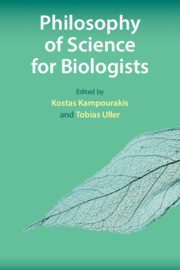Book contents
- Philosophy of Science for Biologists
- Philosophy of Science for Biologists
- Copyright page
- Contents
- Contributors
- Preface
- 1 Why Should Biologists Care about the Philosophy of Science?
- 2 What Constitutes an Explanation in Biology?
- 3 What Is Biological Knowledge?
- 4 What Is the Nature of Theories and Models in Biology?
- 5 How Are Biology Concepts Used and Transformed?
- 6 Why Does It Matter That Many Biology Concepts Are Metaphors?
- 7 How Do Concepts Contribute to Scientific Advancement?
- 8 How Can Conceptual Analysis Contribute to Scientific Practice?
- 9 What Methods Do Life Scientists Use?
- 10 Is It Possible to Scientifically Reconstruct the History of Life on Earth?
- 11 What Is the Basis of Biological Classification?
- 12 What Is the Nature of Scientific Controversies in the Biological Sciences?
- 13 What Is the Relation between Facts and Values in Biological Science?
- 14 A Philosopher in the Age of Creationism
- 15 How Can We Teach Philosophy of Science to Biologists?
- Further Reading
- Index
- References
11 - What Is the Basis of Biological Classification?
The Search for Natural Systems
Published online by Cambridge University Press: 04 September 2020
- Philosophy of Science for Biologists
- Philosophy of Science for Biologists
- Copyright page
- Contents
- Contributors
- Preface
- 1 Why Should Biologists Care about the Philosophy of Science?
- 2 What Constitutes an Explanation in Biology?
- 3 What Is Biological Knowledge?
- 4 What Is the Nature of Theories and Models in Biology?
- 5 How Are Biology Concepts Used and Transformed?
- 6 Why Does It Matter That Many Biology Concepts Are Metaphors?
- 7 How Do Concepts Contribute to Scientific Advancement?
- 8 How Can Conceptual Analysis Contribute to Scientific Practice?
- 9 What Methods Do Life Scientists Use?
- 10 Is It Possible to Scientifically Reconstruct the History of Life on Earth?
- 11 What Is the Basis of Biological Classification?
- 12 What Is the Nature of Scientific Controversies in the Biological Sciences?
- 13 What Is the Relation between Facts and Values in Biological Science?
- 14 A Philosopher in the Age of Creationism
- 15 How Can We Teach Philosophy of Science to Biologists?
- Further Reading
- Index
- References
Summary
Life on Earth is astonishingly diverse. Biologists have so far discovered, named, and described approximately 1.9 million species of organisms (Ruggiero et al. 2015). But on most counts, this is only a very small part of the actual diversity of life on our planet. According to one estimate, there currently exist around 8.7 million (give or take 1.3 million) species of eukaryotic organisms (Mora et al. 2011) – not even counting bacteria and other prokaryotes, which make up by far the largest part of the biomass. Other estimates put the total number of extant species anywhere between 2 million and 1 trillion, with a recent rough estimate being 1–6 billion species (Larsen et al. 2017). But life on Earth is not only extremely diverse when it comes to organismal diversity. Biologists also talk about biodiversity in terms of genetic diversity (e.g., the genetic variation within a particular species, such as the variation of alleles within the human genome, or the genetic variation that exists in a particular local population), ecosystem diversity (the variety of ecosystems found in a particular geographic region, or on the planet as a whole), and the variety of trophic groups in a particular region, as well as other types of diversity (Faith 2016).
- Type
- Chapter
- Information
- Philosophy of Science for Biologists , pp. 216 - 234Publisher: Cambridge University PressPrint publication year: 2020
References
- 1
- Cited by



